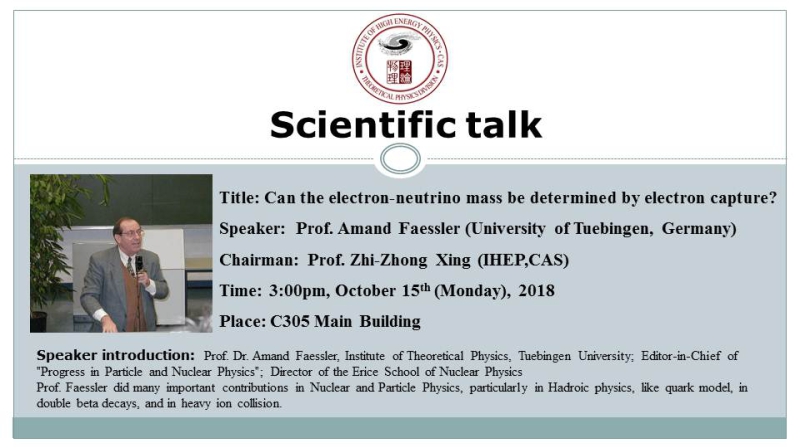Scientific talk
Title: Can the electron-neutrino mass be determined by electron capture?
Speaker: Prof. Amand Faessler (University of Tuebingen, Germany)
Chairman: Prof. Zhi-Zhong Xing (IHEP,CAS)
Time: 3:00pm, October 15th (Monday), 2018
Place: C305 Main Building
Abstract: Electron capture in an atom [e-+ p à n + e-neutrino] is only possible, if the electron wave function has an overlap with the nucleus. This is the case for electrons in the parent atom in ns1/2 and due to the relativistic lower amplitude in np1/2 orbits. The Q-value, energy difference between the parent and the daughter atom, must be large enough to emit a bound ns1/2 or an np1/2 electron into an excited state or into the continuum. For electron capture in 163Ho to 163Dy the Q value is very small Q=2.8 keV and thus optimal for the determination of the neutrino mass.
Energy conservation restricts the capture to 3s1/2 (2 keV binding energy) and 3p1/2 (1.8 keV binding energy) and higher electron orbits in 163Ho. The energy of the Q = 2.8 keV value is used to excite 163Dy* and for the total energy, rest mass and kinetic energy, of the emitted neutrino. The excitation of Dy* can be measured by the total deexcitation energy using a bolometer, which measures photon and Auger electron deexcitations together. The difference between the upper end of this deexcitation spectrum and the Q value = 2.8 keV must be the rest mass of the neutrino. The excitation spectrum in Dy* of one-hole electron states is due to one electron excitation above the Fermi surface (shake-up into bound orbits above the occupied electron states) or into the continuum (shake-off). In addition two-hole and even three hole states are included into the description of the process.
The determination of the electron-neutrino mass seems possible but is definitely difficult. A reduction of the background of about two orders is still needed. Presently are several experiments on its way to measure in this way the electron neutrino mass. The main experiments are:
ECHo by a collaboration mainly from Heidelberg, Mainz and Tuebingen in Germany.
An experiment HoLMES, based mainly on Milano in Italy.
A collaboration NuMEX in the USA, based mainly on Los Alamos.
References:
1)Faessler, Gastaldo, Simkovic, J. Phys. G 42, 015108 (2015)
2)Faessler, Simkovic, Phys. Rev C91, 045505 (2015)
3)Faessler, Enss, Gastaldo, Simkovic, Phys. Rev. C91, 064302 (2015)
4) Faessler, Simkovic, Physica Scripta, 91 (2016) 043007
5) Faessler, Gastaldo, Simkovic, Phys. Rev. C95, 045502 (2017)
6) Faessler, Int. J. Mod. Phys., Walter Greiner Memorial Vol. 2018


